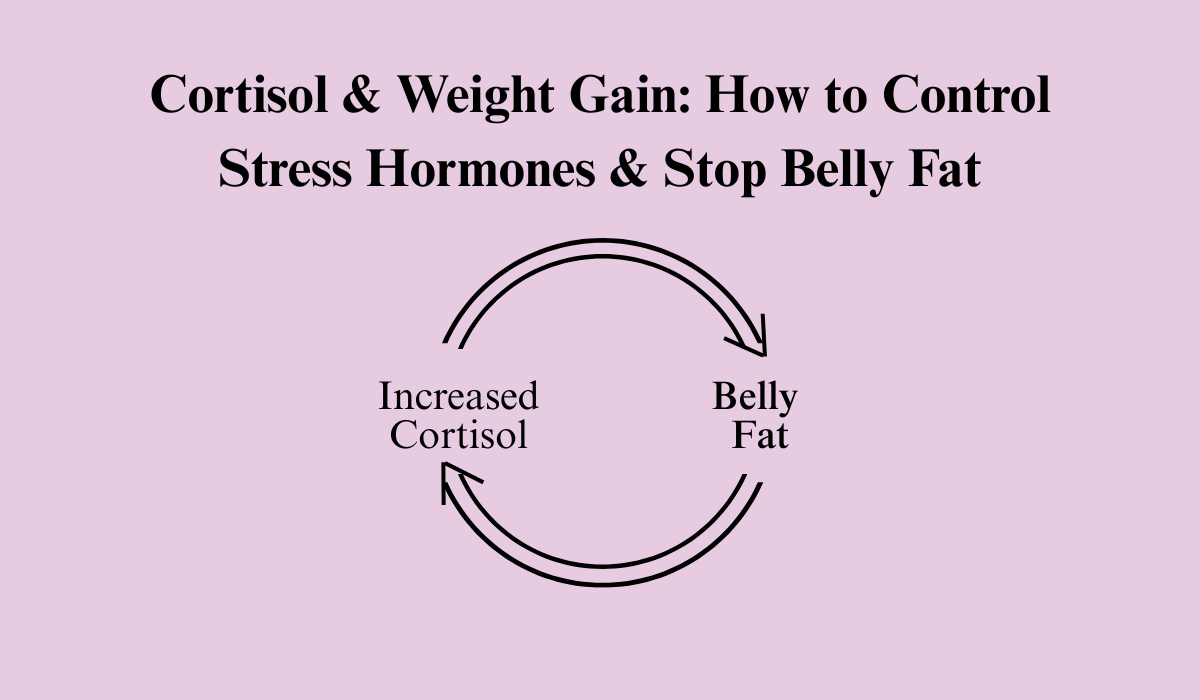If you’ve been doing everything “right”—eating clean, moving regularly, watching portions—but the belly fat just won’t budge, it might not be about calories at all. It could be your cortisol—your body’s primary stress hormone.
Let’s break down how cortisol works, why it loves your waistline a little too much, and how you can start calming this hormone down naturally with food, habits, and a few surprising mindset shifts.
What Is Cortisol?
Cortisol is produced by your adrenal glands in response to stress—physical, emotional, or even mental. It’s essential in small doses: it helps you wake up, respond to danger, and regulate metabolism.
But when stress becomes chronic—hello work pressure, late nights, screen overload, emotional burnout—cortisol stays elevated. And that’s where trouble begins.
How Cortisol Leads to Belly Fat
When cortisol is high for too long, your body goes into “survival mode.” Here’s what happens:
- Increased appetite and cravings, especially for sugar and carbs
- Insulin resistance, which means more fat storage—especially around the midsection
- Disrupted sleep, which further raises cortisol and makes you hungrier
- Loss of muscle mass, slowing your metabolism
- Fat retention in the belly area, even if you’re eating less
This stress-fat cycle is real—and incredibly common.
You Can Turn It Around
The good news? Cortisol can be calmed. You don’t need extreme diets or fancy supplements. What you do need is a shift—in how you eat, rest, and respond to daily stress.
Let’s look at how to naturally reduce cortisol and support belly fat loss from the root.
1. Balance Your Meals to Avoid Blood Sugar Spikes
Unstable blood sugar = cortisol spikes. Every time you skip meals or eat refined carbs alone (think white bread, sweets, plain chai), cortisol is released to rescue your body from the crash.
What Helps:
- Eat within 60–90 mins of waking
- Combine protein + fiber + healthy fat every 3–4 hours
- Don’t skip meals under stress—it makes things worse
Indian Plate Examples:
- Vegetable upma + boiled egg
- Curd rice + roasted peanuts + cucumber salad
- Bajra roti + palak paneer + jeera aloo
- Chana salad with lemon + sesame seeds
2. Eat Foods That Calm the Nervous System
Some foods naturally lower cortisol by calming your body’s stress response.
Add more of these:
- Ashwagandha – an adaptogen that supports adrenal function
- Pumpkin seeds & almonds – magnesium-rich and cortisol-calming
- Banana with a spoon of nut butter – soothing bedtime snack
- Herbal teas like chamomile, tulsi, or nutmeg milk
- Pure cow’s ghee in small amounts – supports brain and gut health
3. Prioritize Deep Sleep (Not Just More Sleep)
Cortisol should naturally drop at night. But if you’re scrolling till midnight or eating late, it stays high and fat-burning shuts down.
Try This:
- Power down screens 60 mins before bed
- Eat dinner 2–3 hrs before sleeping
- Use a calming ritual: warm haldi milk, journaling, soft music
- Sleep in complete darkness to support melatonin and cortisol reset
4. Do “Calm” Workouts Instead of Always Going Hard
High-intensity workouts can increase cortisol—especially if you’re already stressed.
Instead, try:
- Walking after meals – helps with insulin and cortisol
- Yoga or stretching 2–3 times a week
- Strength training (2–4 times weekly) helps burn fat without spiking cortisol
- Avoid heavy exercise late at night—it can keep cortisol high
5. Detox Mentally, Not Just Physically
Your body can’t tell the difference between a real threat and a stressful email. Chronic mental overload = chronic cortisol.
Small But Powerful Shifts:
- Take 5-minute screen breaks every hour
- Practice deep belly breathing: inhale 4 secs, exhale 6 secs
- Journal what’s on your mind before bed
- Say “no” more often—overcommitment fuels burnout
Bonus: Cortisol Needs Morning Sun!
Morning sunlight helps regulate your body clock (circadian rhythm), which naturally lowers cortisol by evening.
- Try to step outside within 30 minutes of waking
- Even 10–15 minutes of daylight (without sunglasses) makes a difference
- Pair it with a walk for double the benefit
Summary: How to Calm Cortisol & Stop Stress Belly
| Habit | What to Do |
| Eat regularly | Protein + fiber + fat every 3–4 hours |
| Prioritize sleep | Calming rituals, darkness, early dinners |
| Choose calming foods | Ghee, ashwagandha, pumpkin seeds, bananas |
| Move smart | Walk, stretch, lift—skip the overtraining |
| Manage mental load | Journaling, boundaries, deep breathing |
| Get sunlight | Morning exposure daily |
Final Thoughts: It’s Not Just About the Belly
Excess belly fat is a signal—not just a cosmetic issue. It’s your body asking for safety, nourishment, rest, and balance.
When you support your hormones gently and consistently, your body will respond. Not with crash diets, but with resilience.
So if your belly has been stubborn, don’t blame yourself. Get curious. Start with your stress. And let food, movement, and rest become your medicine.


